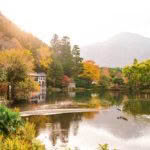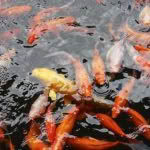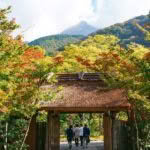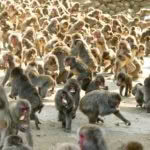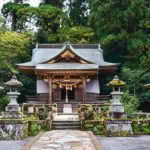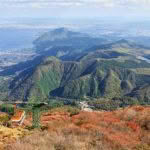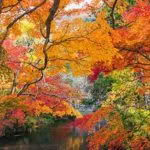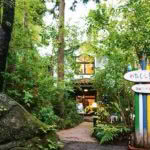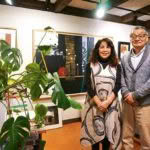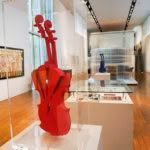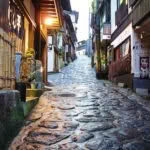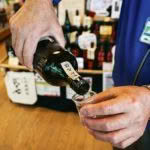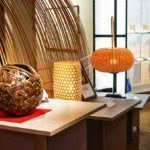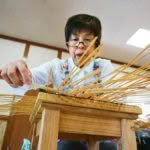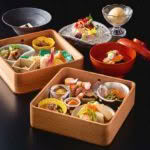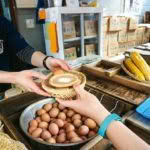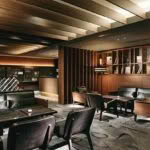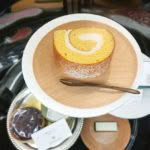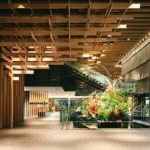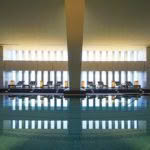Exploring Oita Prefecture on Japan’s Kyushu Island: Where to eat, where to stay and the best onsens to visit
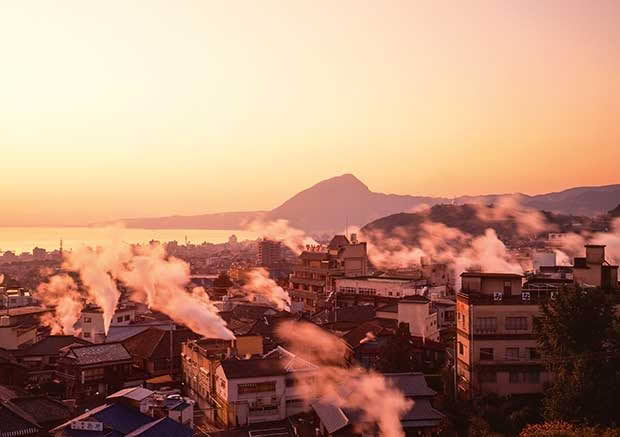
Kyushu, Japan’s southern major island, has rugged mountains, thick forests, glorious food, and plenty of steam. It’s also heating up for this year’s Rugby World Cup.
Words & Photos: Lee-Anne Duncan
Japan’s Ōita Prefecture, on the north-eastern coast of Japan’s Kyushu Island, figuratively bathes in its steamy reputation. The area, famous for its hot springs, has been soaking in its geography for at least a millennium and will stay that way for as long as its three local volcanoes remain active.
Bright white streams of steam emit from the most unexpected areas, and it appears that each hotel and house has a thermal bath of hot mineral water drawn from the ground. Bathing in the hot springs (onsen) and breathing the steam is a way of life for many Japanese. The often mineral-rich waters are used in various ways: to treat ills, to cook with, for warmth, and for bathing and relaxing in. Onsens are also integral to Ōita’s tourism industry, and 7.3 million people travel to the region each year to take the waters. Many stay in ryokan (traditional Japanese inns that, yes, include onsen).
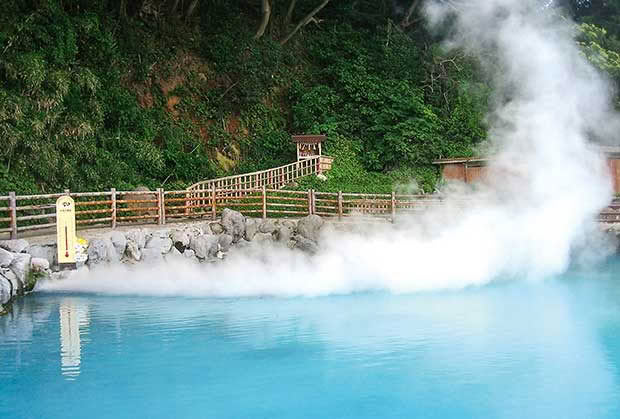
Loving onsen is not a prerequisite to loving Ōita Prefecture but it helps. Cooking oneself, sous-vide, to a glowing rose colour in water at 50 degrees Celsius is heaven for some and scalding hell for others. Me? Initially, I was on the fence. But after a week of bathing my way around the region, I’m all in. Partly because I survived hot water and public nudity, but more so because of the ceremony of it and the partaking of an ancient tradition.
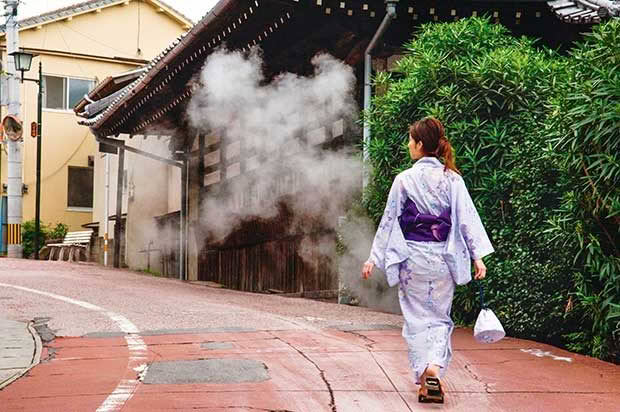 Ōita Prefecture is best-known for its mineral baths, which have attracted locals and tourists for millennia.
Ōita Prefecture is best-known for its mineral baths, which have attracted locals and tourists for millennia.
Total undressing is required – neither underwear nor bathing suits allowed, just a small, strategically held towel. Washing is required (in front of a mirror!), as is a thorough rinse. The waters are hot but, like the proverbial frog, one becomes accustomed. When it all becomes too much, it’s time to leave, feeling invigorated and very, very clean. This year, the prefecture will host at least one All Black game (in Ōita City) during the Rugby World Cup.
Ōita’s already excited; banners declare the tournament a “Once in a Lifetime” opportunity. Whether heading to Japan for the rugby – or anything but rugby – head south into what the Japanese refer to as the countryside but most Kiwis would consider semi-rural at most. For the record, I saw one farm animal during my visit – a solitary cow.
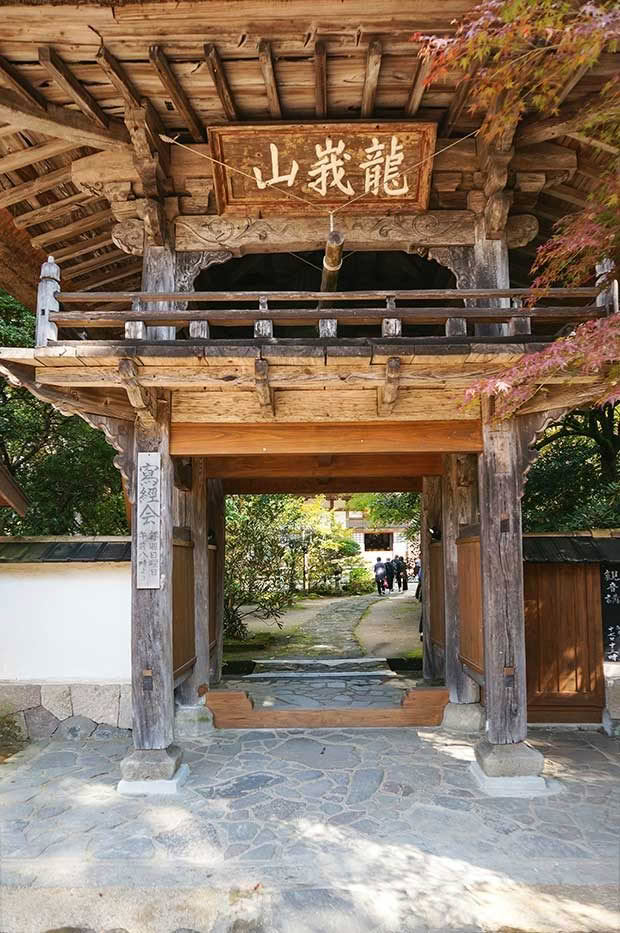 Yufuin’s Bussanji Buddhist shrine.
Yufuin’s Bussanji Buddhist shrine.
I flew from Tokyo to Fukuoka to travel the Yufuin no Mori (Yufuin in the Forest) tourist train from Hakata Station to Yufuin, a delightful alpine town at the base of Mt Yufu (“Yu” means hot water). It’s one of the area’s three active volcanoes and last erupted 1200 years ago creating its double peak and Ōita’s onsen source. Trains are the best way to get around Kyushu, and a Japan Rail Pass (for tourists) can be used on the Yufuin no Mori.
The racing-green train has lashings of old-world charm with shining chrome and gleaming wood, smiling conductors, and – luckily on this three-hour run from Fukuoka to Beppu City via Ōita City – a buffet carriage serving Japanese favourites including a cute bento box from the Michelin-starred sushi restaurant, Takemoto. Four million visitors a year come to Yufuin – a town of 35,000 – for the mountains. Whether bathed in mist or full sunshine (and especially glorious in autumn), the forests are a textured mélange of bamboo, cedars, conifers and maples, with the cedars being the most famous.
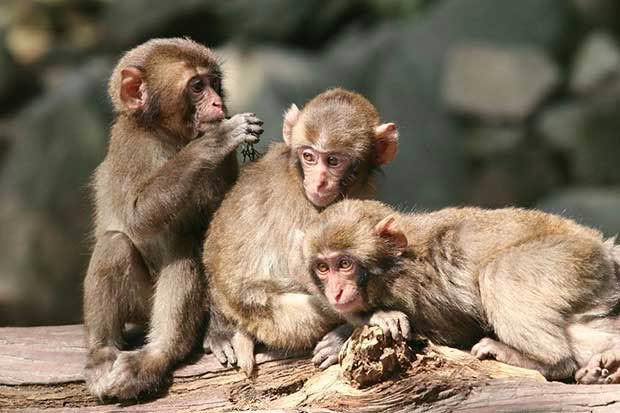 Japan’s native macaques groom each other at the Takasaki National Zoological Garden.
Japan’s native macaques groom each other at the Takasaki National Zoological Garden.
The food too, is superb: try the region’s specialities such as bungo beef (like wagyu “but better”, say the locals), shiitake mushrooms, and kabosu, a lime-like citrus that’s seemingly served with everything.Sightseeing by horse and carriage is an easy way around the main areas of interest. The driver points them out but his commentary is in Japanese. However, it’s nice to just sit and take it all in, clip-clopping past traditional houses, rice fields and orchards, and visiting two local shrines – one Buddhist, one Shinto.
Like many alpine towns, the arts are strong in Yufuin. I took a taxi up winding lanes, lined with homes and punctuated with random, brightly lit vending machines, to Artegio, an art museum celebrating music that sits alongside a café and chocolate shop. Enjoy what’s likely to be the best coffee in the area and sample Yufuin’s famous roll cake – a Swiss roll, only better.
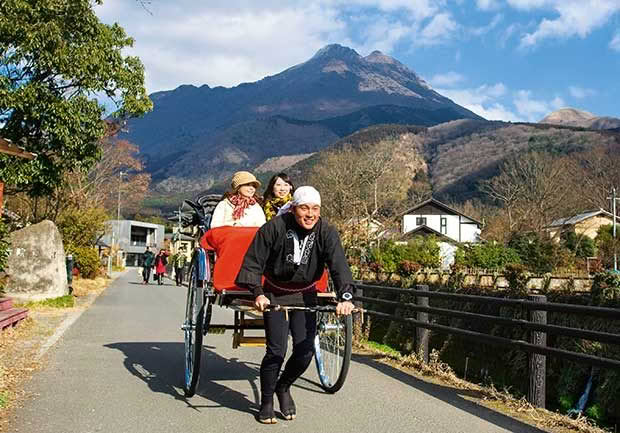 A rickshaw is a zero-emission way to sightsee in Yufuin.
A rickshaw is a zero-emission way to sightsee in Yufuin.
My favourite find was next door; the Watakushi Art Museum displays some of the contemporary art Hideki Miwa has gathered over 50 years, along with pieces painted by his wife, Riko. The art’s not for sale, although Hideki graciously says he’ll consider “good offers”.
The Kamenoi Bessou, built in 1921 as the mountain retreat for the man who first spotted and promoted Ōita’s immense thermal tourism potential (Kumahachi Aburaya) is a traditional Japanese hotel. Kumahachi’s name pops up everywhere. Look out for the statue of him, currently clad in Japan’s rugby stripe, outside Beppu Station. Kamenoi Bessou is a 20-room ryokan, with a five-star rating for its Japanese and European-themed rooms. The tatami-matted, rice-paper-screened traditional rooms are beautiful and were refurbished in 2017. They are highly recommended except for anyone challenged by terrible knees (I grimaced my way through).
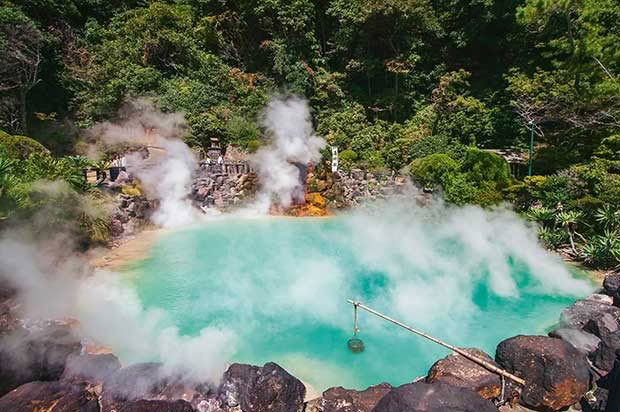
A kaiseki ryori (set-menu dinner) is served in the room by an exquisitely kimonoed nakai (maid) after which, while guests enjoy an onsen – choosing between an indoor or outdoor private bath, or the beautiful public on-site onsen – she returns to lay out the futons.Also recommended, a Japanese whisky in the hotel’s heavily beamed bar. Sip the 18-year-old Yamazaki – it’s as smooth as cognac, with a hint of whisky smoke. A morning stroll in the hotel’s mossy gardens can be followed by a visit to neighbouring Lake Kinrin.
Beppu City, another hour on the Yufuin no Mori train, is the sister city of Rotorua, linked by its steam. Visitors can enjoy countless ryoken and onsen, and a fascinating kitchen where they can steam their own meals in “hell pods”, or grills over gurgling water.
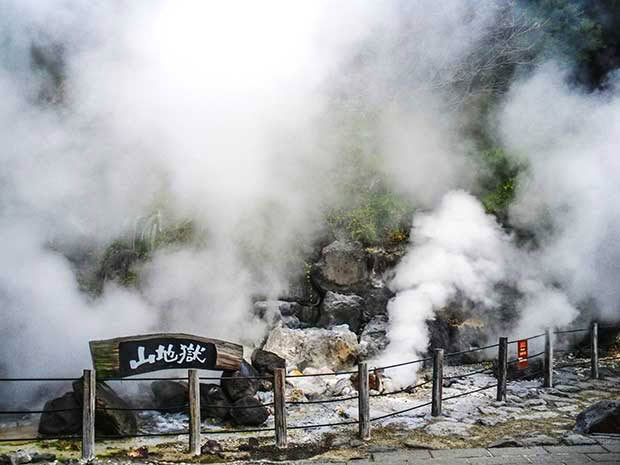 Rising steam and boiling mud makes it easy to see why Beppu is the sister city of Rotorua.
Rising steam and boiling mud makes it easy to see why Beppu is the sister city of Rotorua.
Beppu’s Kannawa area is known for its seven main “jigoku” or “hells”. The name dates back 1000 years when locals feared the area’s boiling water, rising steam and bubbling mud. It’s much friendlier today, with those areas confined into seven, differently themed jigoku. Note: the pools are about 100 degrees Celsius and not for human bathing, but do try the steamed eggs at Kamado Jigoku – 24 hours of steaming turns the egg white quite brown and imparts a meaty flavour. It’s much better than it sounds.
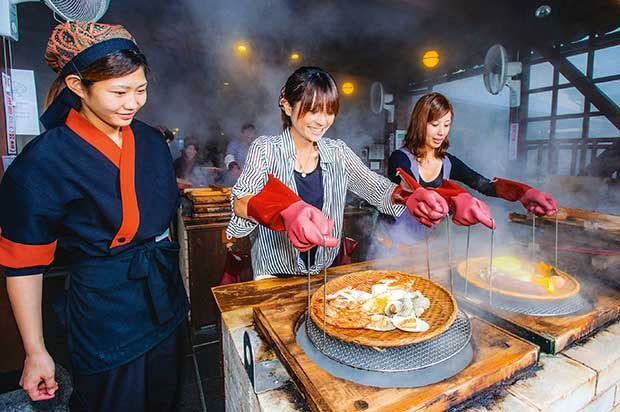 Steamed food is an Ōita speciality. Many restaurants offer jigoku mushi, or food that has been steam-cooked using the local hot spring water. Diners are often able to choose seasonal ingredients and condiments from a menu and cook the food themselves.
Steamed food is an Ōita speciality. Many restaurants offer jigoku mushi, or food that has been steam-cooked using the local hot spring water. Diners are often able to choose seasonal ingredients and condiments from a menu and cook the food themselves.
Above it all, is the Beppu Ropeway in Aso-Kuju National Park on the slopes of an active volcano, the closely-monitored Mt Tsurumi. The 1375-metre mountain is ever-changing: white with snow in winter, green in spring, azalea pink in summer and coloured in sunset hues come autumn. A few moments of peace at the Shiki no Sato (Homeland of Four Seasons) garden below the ropeway can be useful before crossing the road to buy some shochu at Kyushu Shochu-kan, a liquor and gift shop. Kyushu produces 500 brands of the spirit, which is usually distilled from barley or sweet potato. I found I prefer the barley. Shochu tastings are available only on weekends or holidays, but I’d chance it and ask for a taste anyway.
- Morning mist on Yufuin’s Lake Kinrin — the name means “golden fish scale” — caused when the cold and hot water springs feeding the lake converge.
- densely populated ponds of brightly coloured koi carp are a common sight in Japan; visitors to the five-star hotel Kamenoi Bessou pass through a traditional Japanese gateway.
- Mt Yufu, shrouded in cloud, is in the distance.
- Macaque monkeys are fed every half hour at Takasaki National Zoological Garden.
About 30 minutes’ drive around the bay from Beppu City is the Takasaki National Zoological Garden, home to an estimated 1000 native macaques. It might be called a zoo but the monkeys are not caged and since they’re fed every half hour they aren’t likely to leave. Wild monkeys have been living this way on Mt Takasaki since 1952 when the zoo/garden was set up by local authorities to develop the animals as a tourist attraction and to protect them from farmers, angry at the cheeky blighters destroying their crops.
On the edge of Ōita City is the Ōita Stadium, the multi-purpose venue built for the upcoming rugby tournament and where the All Blacks will (assuredly) win a pool game come October. There’s excellent shopping and eating around the railway station in the massive Galleria, the food halls below the Tokiwa Department Store. My hotel – JR Kyushu Hotel Blossom Ōita – had what I feel was the best view from any outdoor onsen anywhere. If the hot water doesn’t soothe, the view across the city lights will.
- The Unagihime Jinja Shinto shrine in Yufuin.
- The Beppu Ropeway can take up to 100 tourists to the top of Mt Tsurumi to enjoy the expanse of Beppu Bay.
- Steam isn’t the only attraction in Ōita — the prefecture is also known for its autumn colour.
Swapping hot steam for the big smoke of Tokyo, I took a 90-minute flight from Ōita and moved quickly to fit as much as possible into my one day in the capital. The Capitol Hotel Tokyu, in the Akasaka area of Chiyoda-ku (ward), is in a lively area of town (where isn’t?) and opened in its current form in 2010 after a four-year rebuild. The hotel’s exterior and lobby was designed by one of Japan’s foremost architects, Kengo Kuma, who designed Tokyo’s $1.9 billion (give or take) Olympic Stadium, which is still being built.
The hotel lobby is in Kengo’s distinctive style – but this time the signature slats of cedar are interlocked, replicating the look of a Shinto shrine. SaRyoh, its executive lounge is reminiscent of a traditional tea cottage and is where guests with “club floor” rooms (read: the swankiest) check in. The Capitol Hotel Tokyu’s top restaurant, Suiren – merely one of many eating and drinking areas in the building – is superb, serving a multi-course kaiseki ryori (Japanese haute cuisine), as well as featuring separate sushi, teppanyaki and tempura bars.
- Ōita has a strong arts culture.
- In Yufuin, at Watakushi Art Museum and Gallery Riko, the private collection of Hideki Miwa and the works of his wife, Riko are on display.
To see more of Kengo’s work, take the train to Omotesando Station and walk up Miyuki, the chicest of streets (the Prada building is a bubble-like highlight) to the Nezu Museum, which he designed. Enjoy the fascinating Chinese and Japanese antiques inside, then stroll, relax and take tea in a Japanese garden right in the middle of the city. Many New Zealanders may have dipped their toes into Japan, but next time try for immersion in Ōita – the water’s great.
Travel notebook
GOOD TO KNOW
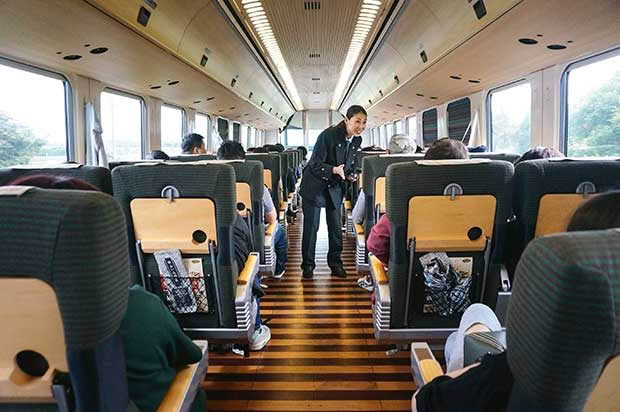
Little English is spoken in Japan, even in Tokyo. But the Japanese are unfailingly polite and will try their best. English is taught at school, so writing down a request might help as reading another language is often easier. Learning a few polite phrases and critical kanji before departure is advised.
GETTING AROUND
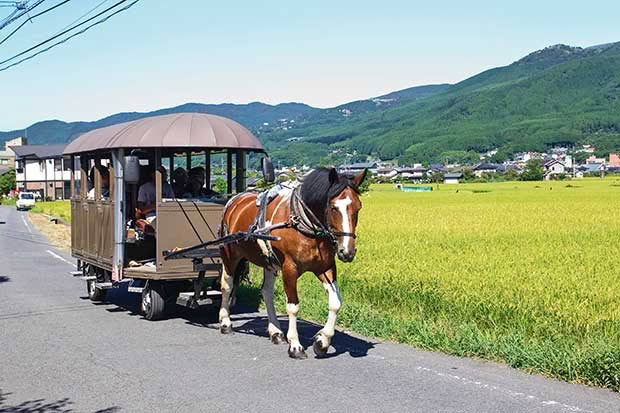
Uber still isn’t widely available in Japan, but the trains are great and taxis reasonably priced. In Tokyo, buy a PASMO card and load it with credit to use across all transport systems. Remember to choose “international languages” on the home screen of the ticket machines so you can choose your options in English. The subway maps are in Japanese, but each upcoming stop’s name is displayed on a digital screen over the carriage doors. Queue between the platform’s painted yellow lines — boarding in Japan is polite, no pushing and shoving. Trains are a great way to get around, and it’s economical to invest in a Japan Rail Pass, which can be used on tourist trains such as the Yufuin no Mori. In Yufuin, go sightseeing by horse and carriage.
WHERE TO SHOP
Ōita: Get lost in the giant Galleria just by the railway station, and in the Tokiwa Department store, especially the bottom food floors. As the name suggests, the Ōita Made Shop, in the red-brick Ōita Bank Building, sells quality locally made products. Then walk around the corner and down Fifth Avenue, a pedestrianized lane lined with cool cafés, bars and clothing shops.
Tokyo: Head straight for the popular neighbourhoods of Shibuya and Shinjuku. For a more relaxed vibe, try Omotesando Avenue in Mintao-ku.
WHERE TO EAT
Yufuin: Yufuin Sanshourou is a popular local restaurant mentioned in the Michelin Guide.
Beppu: Japan does excellent Italian. Otto e Sette in Beppu City offers stunning food with well-priced set menu at lunch and dinner, as well as à la cart. Also try Suiten — there’s a sushi train, but most diners choose from the menu.
Ōita: For dinner, consider Oogami, a swept-up izakaya, or casual eating place. It’s a little difficult to find so let Google Maps help. Ask the waiter for Ōita’s speciality dishes — there are plenty of them, including ryukyu or white fish with spring onions, sesame and soy, which is delicious.
Tokyo: Suiren in the Capitol Hotel Tokyu is sophisticated and discreet, and has a wide range of exquisite dishes. As it’s close to the Japanese Parliament, it’s a favourite of the high-powered.
WHERE TO STAY IN TOKYO
The Capitol Hotel Tokyu is a luxury hotel with every service required for a wonderfully comfortable stay in the city. It features views of the Emperor’s Palace Gardens, several paintings by famous Japanese abstract artist, Toko Shinoda, and easy access to the Metro.
Like any Japanese hotel, the toiletries on offer are extensive, but to reduce waste the hotel runs a Green Coin programme whereby if guests don’t use them and hand in the green coin on check out, the hotel donates to its Green Coin programme to fund reforestation projects.
ONSEN ETIQUETTE
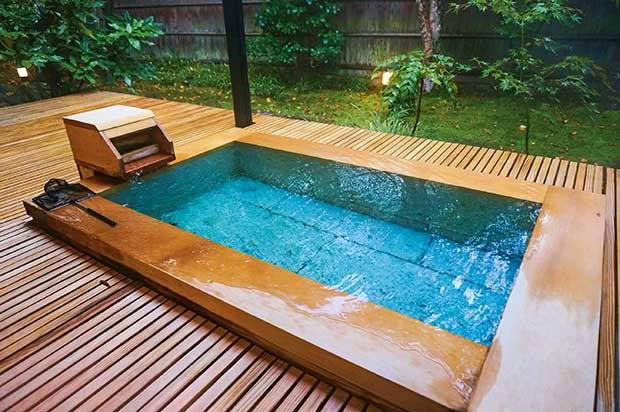
● It’s a must to bathe in an onsen. Any hotel Ōita in worth its steam has one so be brave and try it, or be braver and find a local public onsen. * No one takes any notice of each other’s nudity — honest.
● Note the opening hours —
these may be different for men and women.
● Pick the right onsen — the sexes have separate onsens, the genders usually indicated by red or pink for women and blue or black for men.
● Nudity is a must — no bathing suits or underwear allowed.
● Use the showers to thoroughly soap and rinse before going in.
● A towel is allowed for modesty when walking around but don’t take it into the pool.
● No washing in the pool — they are for soaking and relaxing.
● Always act respectfully towards other users — don’t talk loudly or stare.
● If in a private onsen, don’t drain the bath when finished.
Lee-Anne Duncan traveled with the support of JTB New Zealand, Õita Prefecture and Tokyu Hotels Japan. With more than 20 years’ experience in deliveringunforgettable trips to Japan and beyond, JTB New Zealand is an expert on Japan.Its packages are tailored to travelers’ needs and interests, and it offers New Zealand’s widest selection of Japan travel options for all budgets. jtboi.co.nz
Love this story? Subscribe now!
 This article first appeared in NZ Life & Leisure Magazine.
This article first appeared in NZ Life & Leisure Magazine.
